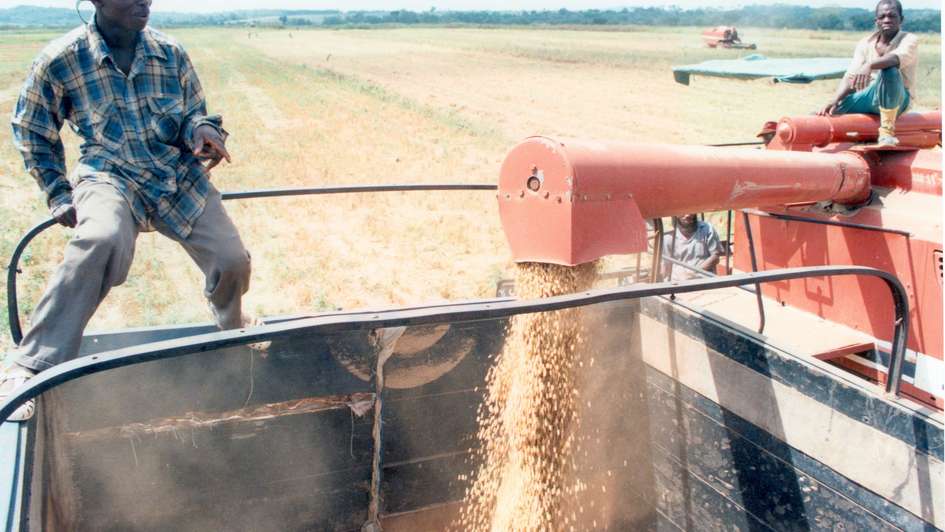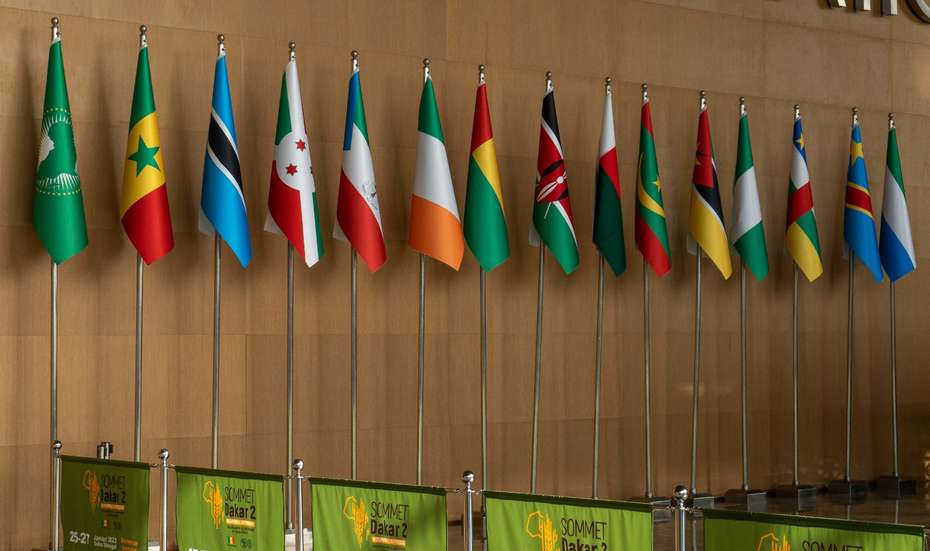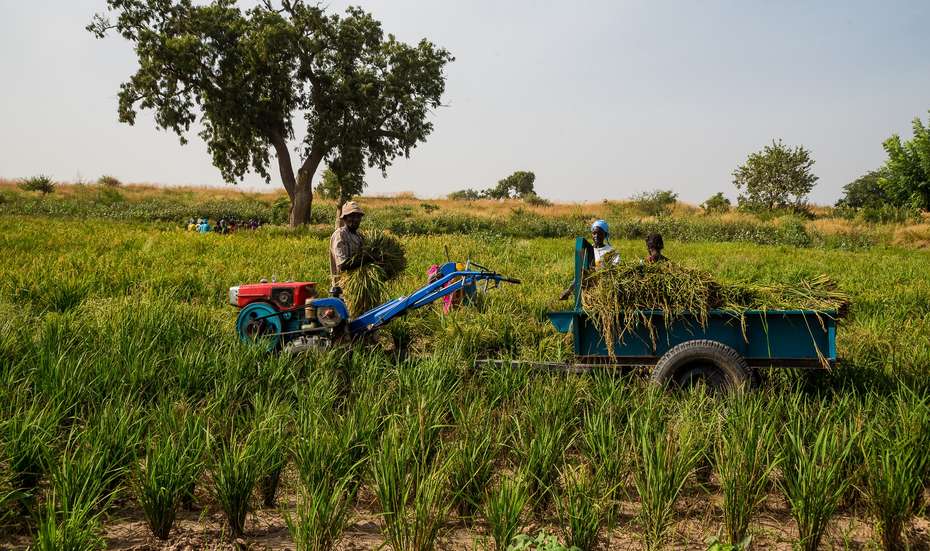How much do African States spend on Agriculture?
By Moumini Savadogo
02/28/2024The continent is not achieving the goals set ten years ago in Malabo. Nevertheless, there has been growth, albeit on a lower level. New guidelines for public investment in agriculture are required.
 Harvest in Senegal. Mechanisation in African agriculture stands at about ten percent. 65 percent of labour is performed by humans, about 25 percent by draught animals. © AfDB via Flickr
Harvest in Senegal. Mechanisation in African agriculture stands at about ten percent. 65 percent of labour is performed by humans, about 25 percent by draught animals. © AfDB via Flickr
Most African countries have not reached the Malabo target of investing 10 percent of their national budgets in agriculture. But focusing only on the Malabo target disguises the fact that public investment in agriculture has nevertheless risen significantly. To make African agriculture more resilient to shocks and improve food security and agri-food systems, more public and private investment is urgently needed.
When African Heads of State and Government met in Malabo/Equatorial Guinea in June 2014 they made the historic commitment to spend ten percent of their national budgets on agriculture. In adopting the Malabo Declaration the African leaders supported further far-reaching goals, such as:
- ending hunger in Africa by 2025
- halving poverty by 2025 through inclusive agricultural growth and transformation
- boosting intra-African trade in agricultural commodities and services
- enhancing resilience of livelihoods and production systems to climate variability and other related risks, and
- mutual accountability to actions and results.
The Malabo Declaration was made within the framework of the broader Comprehensive Africa Agriculture Development Programme (CAADP). CAADP calls for an agriculture-led development that eliminates hunger, reduces poverty and food insecurity and facilitates higher sustainable economic growth and development.
The CAADP and Malabo initiatives are important milestones in the process of agriculture-led economic growth in Africa after the structural economic adjustment period. It was an innovative process that raised the profile of agriculture and encouraged better policies and significant investments on agriculture as the key driver of economic growth and prosperity.
Overall, the progress in implementing CAADP has been commendable and most CAADP indicators have trended positively since 2003 (2). Compared with the rest of the world, Africa has the fastest growing agriculture sector since 2000. Research shows that the agricultural value-added index, measuring processes that increase the value of primary agricultural commodities, more than doubled between 2000 and 2020. However, overall economic growth and the reduction of inequality, poverty, and undernourishment have decelerated while child malnutrition remains relatively high on the African continent.
Far less positive has been the achievement of the Malabo committment on allocating 10% of national budgets to agriculture. The allocation of public finances to agriculture has been far below the Malabo target. Nevertheless, focusing only on the Malabo commitment distorts reality because African countries have made important progress in investing and improving their agriculture.
Malabo Targets have been missed
The African Union (AU) and its partners have put in place a rigorous monitoring, evaluation, and mutual accountability process. This includes the provision of data, policy analysis, and capacity-strengthening support to enable AU Member States to achieve economic transformation and shared prosperity. An interactive website and a flagship Annual Trends and Outlook Report track progress made on achieving core CAADP indicators. The CAADP Biennial Review (BR) reviews country, regional, and continental progress toward meeting the 2014 Malabo Declaration commitments.
The 3rd CAADP Biennial Review on the progress achieved of the Malabo Declaration commitments was published in 2022. It underlined that the African “continent is still not on track to meet the CAADAP/Malabo Commitment by 2025”.
Out of the 51 AU Members States only one country, namely Rwanda, is on track to achieving the Malabo commitments. Only four countries achieved the target of allocating 10% of public spending to agriculture (Burundi, DR Congo, Ethiopia and Mali). Four member States (Egypt, Eswatini, Seychelles, and Zambia) were on-track, which is an improvement since no country was on track in the last review period for this indicator. Five countries (Burkina Faso, Ethiopia, Malawi and Niger) achieved consistently the 10% target from 1980 to 2020. Countries like Benin, Mozambique, Senegal and Sierra Leone have achieved the target in some years only after the pledge was made.
Financial Support for African Agriculture
But the focus on the more general Malabo commitment hides that Africa has mobilized important – though not sufficient – funds in support of its agricultural sector. Data shows that public expenditure on agriculture (PAE) has nearly doubled in Africa, increasing from $10.7 billion in 2000 to $17 billion in 2021. The share of PAE in total public expenditure declined from a 3.9% annual average share in 2000-2008 to 2.7% and later to 2.4% in 2020. We should not forget that public investments in agriculture remained low because countries had to equally meet large investment demands in infrastructure and social services following more than two decades of economic stagnation up until the late 1990s.
The agriculture value added has doubled, increasing from $200 billion to $425 billion. It shows that Africa is allocating smaller amounts in PAE relative to the size of the continent’s agriculture sector. However, the value added for agriculture, based on an increase in agricultural land, labor and food processing productivity, has increased in many countries and some have started reinvesting an important share of it back into the agriculture sector in support of agriculture investment plans. With this trend, there is an opportunity to significantly boost agricultural investment by returning more of the wealth created in agriculture back to the sector.
Africa has the world's fastest growing agriculture sector since 2000.
Africa realized sustained economic growth in the last two decades and managed to double its GDP from $1.2 trillion in 2000 to $2.7 trillion in 2021. Economic growth was especially high during the early 2000s, with 5.5% growth in GDP in real terms between 2000 and 2008. However, the COVID-19 pandemic and other headwinds, such as the Russia-Ukraine war, have posed major challenges to sustaining the strong growth of the last decade. At the onset of the pandemic, GDP per capita growth contracted by 5.3% in real terms and its value per capita in 2021 was equivalent to the amount recorded a decade ago in 2010.
The agriculture labor productivity rose by 50% and the land productivity by 100% during the period. This resulted in a significant improvement of the agriculture value added recorded for Africa as a whole. It more than doubled in constant 2015 dollar terms within the last two decades, increasing from around $200 to $425 billion between 2000 and 2021. On average, agricultural value added grew at 4.1% annually between 2000 and 2015 and at 3.2% during 2016-2021. Liberia and Zambia have been able to invest back 77% and 63%, respectively in their agricultural sector. These are good examples that other countries could follow.

Agricultural labor productivity almost grew by half within the last two decades, rising from $1323 in 2000 to $1874 by 2021, measured by agriculture value added per worker at constant 2015 dollar value. Land productivity measured by agriculture value added per hectare of agricultural land more than doubled during the reporting period.
Intra-African agricultural trade performance
The increase of productivity had a strong impact on intra-African agricultural trade performance which increased by 175% from $5.4 billion to $14.9 billion between 2003 and 2021. In general, the 2009-2015 period showed the greatest performance with intra-African agricultural trade of $13.5 billion on average per year, mostly driven by processed food commodities, especially cassava.
Africa’s global agricultural export significantly increased from $25.3 billion in 2003 to $73.2 billion in 2021. The share of intra-African agricultural trade in global agricultural export showed a declining trend in the recent past, but it started to pick up in 2021. About 20% of Africa’s export is within the continent. This shows that the continent has huge opportunities to further increase its intra-African trade provided that conducive investment and trade policies are in place.
Towards a post-Malabo agenda
The CAADP/Malabo process has paved the way for evidence-based agricultural policy planning and results tracking to ensure steady progress towards the Africa we want. The strong expertise and robust instruments set up through the last two decades are indicators of the effectiveness of Africa’s agriculture-led growth and sustainable development. The African Union Commission and its partners have started the process of data analysis, drawing lessons from the past to design the post-Malabo agenda.
One of the important lessons learned is to expand public expenditure on agriculture and make it more specific, i.e. with a new target tracking the level of public agricultural expenditure as a share of agricultural GDP and not the general GDP. This will facilitate resource mobilization and justify the level of agricultural expenditure based on the wealth created by the sector. It could take away the competition with other sectors in budget allocations and could be a strong argument for higher public funding, following the examples of Liberia and Zambia.
More public and private investments are urgently needed to sustainably improve and transform agriculture and agri-food systems in Africa along the value chain, especially for food processing, resilience to climate and other shocks, inputs, soil health, bioeconomy and innovative technologies including artificial intelligence and digitalization.
First published in the Welthungerhilfe Global Food Journal.

